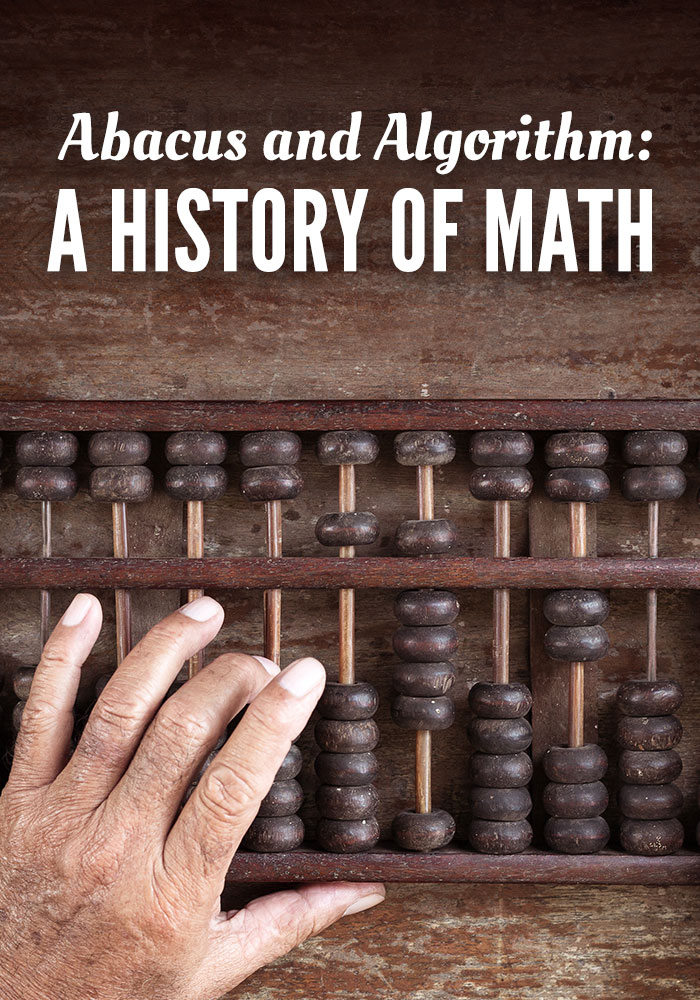Abacus and Algorithm: A History of Math

We often teach mathematics as if it were ahistorical, as if all mathematical insights – from the concept of zero to theories of infinite sets – were known always and everywhere. Studying the history of math allows us to see mathematics as an ongoing conversation that has its roots in the earliest of human civilizations. In her book The Abacus and The Cross, scholar Nancy Marie Brown introduces us to a medieval mathematician named Gerbert (later Pope Sylvester II), the man responsible for introducing algebra to medieval Europe and for giving us the place-value system that we still use all these centuries later.
The Quadrivium
Brown notes that during his days in a French monastery, Gerbert was instructed in the quadrivium, the four-fold foundation of knowledge in arithmetic, geometry, astronomy, and music that had been formalized by Alcuin of York during Charlemagne’s reign. In these studies, Gerbert was heavily influenced by the thinking of the early philosopher Boethius who taught on the musica mundana: the Music of the Spheres. For Boethius, the turning of the astronomical spheres produced a heavenly music that held the stars together. This music was believed to parallel the musica humana which held together the body and soul. This concept extends forward beyond Gerbert and finds itself most famously recorded in Dante’s Paradiso wherein he writes of “the Love that moves the sun and the other stars.” In short, for Gerbert, the qadrium offered an integrated view of the cosmos and of man’s place in that cosmos.
The Abacus
Gerbert used visual aids to teach the quadrivium, including a wooden sphere to show the motion of the planets, an elaborate abacus, and, the one-stringed instrument known as a monochord. An abacus was an elaborate counting machine, first pioneered by the Romans (see below), and the rudimentary basic for both the calculator and the computer.

Gerbert used a shield-maker to assemble a light, counting board version of abacus that he used to teach his students. Notably, because Gerbert had studied in Muslim Spain, he used Arabic numerals. What are Arabic numerals? They’re the notation you use in everyday math: 0, 1, 2, 3, 4, 5, 6, 7, 8, 9. Prior to Gerbert, Roman numerals were used, or letter notation.
Introducing Arabic numerals was not the only lasting contribution Gerbert made. As Brown explains:
Gerbert’s abacus board introduced the place-value method of calculating that we still use today.
Specifically, each column represented a power of ten. “The ‘ones’ column was placed farthest to the right, and the numbers increased by a multiple of ten.” Incredibly, “with twenty-seven columns, Gerbert could add, subtract, multiply, or divide an octillion (1027).” Gerbert called these columns “intervals,” which was likely an allusion to Boethius’ use of the word in music theory. He also called any number put in the first column a “digit” which is Latin for finger. Gerbert gives detailed instructions for how to count on your fingers, but those instructions will likely strike you as strange: for example, “when you say one, bend the left little finger and touch the middle line of the palm with it. When you say two, bend the third finger to the same place.”
As another fun but important aside, one of Gerbert’s near contemporaries, Ralph of Laon, helps to explain why then (as now), counting begins with the “ones column.” Trying to explain the concept of zero, Ralph of Laon writes: “even though it signifies no number, it has its uses.” It was only much later that zero as a concept came to signify a number. In Gerbert’s mathematics, zero is mostly a placeholder, whereas for us zero signifies an actual number. Aside from this shift in thought, Brown writes, “For a thousand years, we have added, subtracted, multiplied, and divided essentially the same way Gerbert taught his students at the cathedral school in Reims.”
Adelard’s Algorithm
The main transition between Gerbert’s math and our own was the introduction of Adelard’s algorithm in the in the 12th century. Brown writes:
The step from Gerbert’s abacus to Adelard’s algorithm was very small. The main difference between the two ways of calculating was that the pre-drawn column lines of the abacus board disappeared; they were no longer needed once the place-value system was fully understood. In the algorithm, placement on the page alone distinguished a one from a ten or a hundred, and the use of zero to fill the empty space became standard.
Ralph of Laon was right: zero really does have its uses. And in case the word algorithm caught your attention, note that it was this development in mathematics (first initiated by the Muslim scholar al-Khwarizmi, from whose name the word algorithm is derived) that eventually paved the way for binary coding, and thus for the algorithms that power our computers and smartphones.
I hope this brief overview of Gerbert’s mathematics has piqued your interest in the history of mathematical thought. If you want to introduce your student to more history of math, check out The Story of Mathematics: this excellent online resource traces the story of math in ancient Sumerian and Babylonian culture all the way through to important developments in the 20th century.
